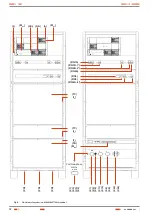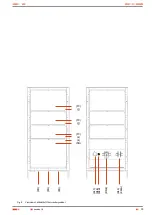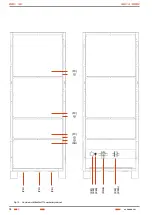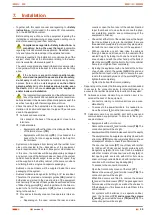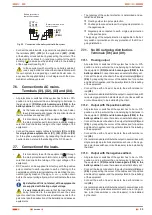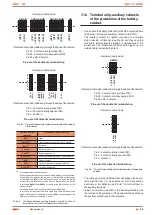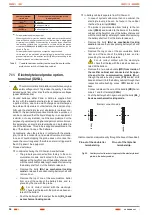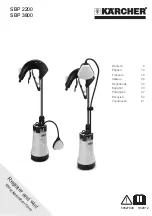
25
SALICRU
By default the standard dry contacts from 1 to 3 are preset from
factory, being able to reprogram them. The other 6 are optional
and programmable too, being able to set one of the available
alarms in the system or to associate more than one alarm to the
same dry contact.
5.2.2.2. COM ports.
There are two RS232 ports supplied through DB9 connectors
and labelled as COM1 and COM2. In case of installing the tele-
maintenance SICRES card option, COM1 is disabled.
Also, there is a RS485 in COM3 port, which is supplied in 3 pins
connector.
The RS232 from COM2 channel and RS485 from COM3
channel are mutually exclusive between them, so they can't be
used at the same time.
5.2.2.3. Telemaintenance SICRES card (option).
The telemaintenance SICRES card allows monitoring, analysing
and giving technical support in real time, 24 hours per day, 7 days
a week by professionals of our firm, decreasing the MTTR (Mean
Time To Repair) against any unexpected event.
During the monitoring, a data logger of the events and alarms
is generated, which allows an exhaustive analysis of the equip-
ment, giving a valuable information of the operating trend, so in
this way the potential future problems can be identified. Likewise,
each month, it is sent a detailed report to the client of the status
of the equipment.
5.2.3. Operating modes.
•
Normal mode.
Load is supplied from rectifier modules directly. Meanwhile
the system takes the energy from the AC electrical commer-
cial mains and supplies DC energy to the loads. At the same
time, batteries are kept on floating mode, because they are
connected in parallel with the output of the system. For those
cases that the system is overloaded, battery will take any in-
rush current that system is not able to supply.
•
Emergency mode.
In case of mains fault, the connected load to the system is still
being supplied, but now by the batteries instead of the recti-
fier modules. There is not any break in the power supply to
the loads, during the transference from normal to emergency
modes and vice versa.
•
Recharging mode.
When the electrical mains is restored, the rectifier starts auto-
matically and recharges the batteries and supplies the loads
at the same time. It means that the DC output voltage will
always be the same as the battery voltage.
5.2.4. Cycling function and Smart mode.
Usually the system is sized to the estimated power of the loads,
plus the battery charging current and finally the redundant mod-
ules are added to the system. But in most of the cases, as the
rectifier modules are connected in parallel and sharing the load,
all of them works at half power, which means having a lower ef-
ficiency.
To solve this phenomena, the Control Module includes the Smart
mode. This operating mode entail in shutdown the redundant
modules and any of those ones that are not needed to, in order
to get the correct quantity of modules operating at the maximum
efficiency level (this figure can be set through the LCD panel).
In case of failure of any of them, the Control Module will start up
any of the shutdown modules (on Standby) to replace the faulty
module. This way, an optimal efficiency of the system is get along
its lifetime.
In order to age all the parts and elements equally when the Smart
mode is enabled, the Control Module has the cycling function.
This function entails in swapping the shutdown modules with the
ones that are already started up, therefore the aging is the equal
for all of them. The preset cycling period is 10 hours, neverthe-
less the client can set it at the required time.
SMART-mode.
Load sharing on normal operating.
Rectifier load sharing and cycling on Smart mode.
Fig. 15.
Graphic of the possible operating modes of the system.
5.2.5. Battery.
Even tough the AC input mains fails, the equipment will operate
as an autonomous power supply, by providing voltage to the load
connected at the output of the equipment, because it has a bat-
tery that will supply the energy.
To keep the battery in the optimal status, the system monitors the
current and voltage of the battery at any time, as well as the tem-
perature of the battery room to make the corresponding compen-
sations, in order to prolong the battery lifetime to the maximum.
A low voltage contactor protects the batteries from being com-
plete depleted, avoiding their irreversible deterioration, particu-
larly in the PbCa batteries.
The system can charge any type of batteries of PbCa or NiCd,
either sealed or with maintenance. A electrolyte level probe can
be added, as an option, to the batteries with maintenance, which
will trigger an alarm in case of low electrolyte level in the battery
cells.
The rectifier cabinet has protections in both poles, which as well
as its own functionality, it allows connecting and disconnecting
the battery set to the rectifier.
Summary of Contents for DC POWER-S DC-36-S
Page 2: ......
Page 18: ...18 Case with casters dimensions Cabinet dimensions 605x605x1315 mm 605x805x1315 mm USER MANUAL...
Page 42: ...42 USER MANUAL...
Page 43: ...43 SALICRU...


